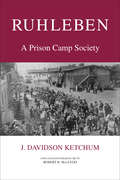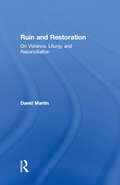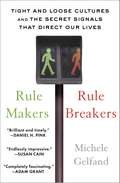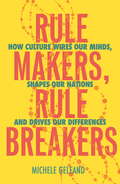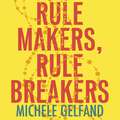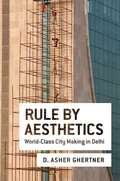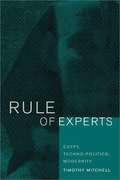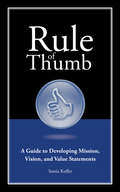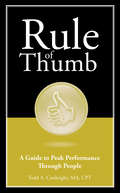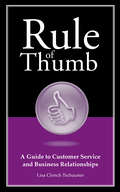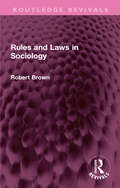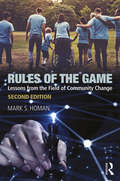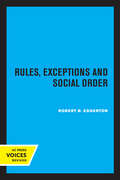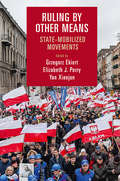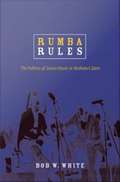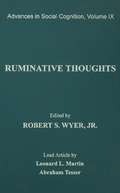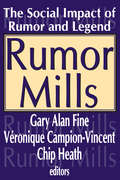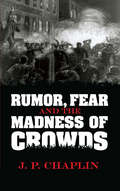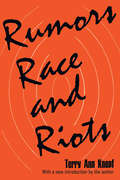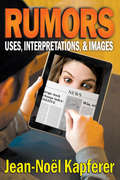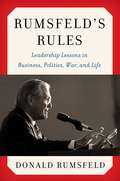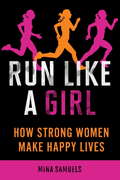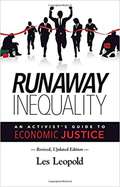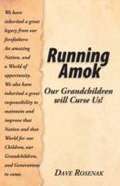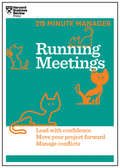- Table View
- List View
Ruhleben: A Prison Camp Society (Heritage)
by J. Davidson KetchumThis is an unusual book in that it is an important contribution to social psychology and also an absorbing story of four strange years in a German prison camp of World War I. Four thousand men and boys from the most varied walks of life—professors, seamen, jockeys, schoolboys, bank directors, musicians, clerks, scientists—were taken from civilian life and placed in Ruhleben on the outbreak of war; no activities were prescribed for them, no direction was given to their communal life. In the event, this miscellaneous group of people, closed off from the world, create d their own society. This book is the story of how they did it and what the society they made was like; much more than this, the camp provides a gifted and sympathetic social psychologist with a rare opportunity for study and analysis of an important if inadvertent social experiment. The time elapsed between the event itself and the completion of the book may in one way be regretted; it did, however, allow the author, who was himself and inmate of Ruhleben, the opportunity for mature reflection on its meaning. The book is a contribution to the history of World War I; it is also a basic and timeless study of the dynamics of individual and group behaviour.
Ruin and Restoration: On Violence, Liturgy and Reconciliation
by David MartinTo suppose that God has a providential plan based on a special covenant with Israel and realised in the atonement presents us with a moral problem. In Ruin and Restoration David Martin sketches a radical naturalistic account of the atonement based on the innocent paying for the sins of the guilty through ordinary social processes. An exercise in socio-theology, the book reflects on the contrast between ’the world’ governed by the dynamic of violence as analysed by the social sciences, including international relations, and the emergence in Christianity (and Buddhism) of a non-violent alternative. A ’governing essay’ fuses frameworks drawn from Reinhold Niebuhr, Karl Jaspers, Ernst Troeltsch and Max Weber and explores the relation between the cultural sciences, especially sociology, and theology treated as another but very distinctive cultural science. Six commentaries then deal with the atonement in detail; with the nature of Christian language and grammar, and with its characteristic mutations due to necessary compromises with ’the world’; with sex and violence; and with the liturgy as a concentrated mode of reconciliation.
Rule Makers, Rule Breakers: How Tight and Loose Cultures Wire Our World
by Michele GelfandA celebrated social psychologist offers a radical new perspective on cultural differences that reveals why some countries, cultures, and individuals take rules more seriously and how following the rules influences the way we think and act.In Rule Makers, Rule Breakers, Michele Gelfand, &“an engaging writer with intellectual range&” (The New York Times Book Review), takes us on an epic journey through human cultures, offering a startling new view of the world and ourselves. With a mix of brilliantly conceived studies and surprising on-the-ground discoveries, she shows that much of the diversity in the way we think and act derives from a key difference—how tightly or loosely we adhere to social norms. Just as DNA affects everything from eye color to height, our tight-loose social coding influences much of what we do. Why are clocks in Germany so accurate while those in Brazil are frequently wrong? Why do New Zealand&’s women have the highest number of sexual partners? Why are red and blue states really so divided? Why was the Daimler-Chrysler merger ill-fated from the start? Why is the driver of a Jaguar more likely to run a red light than the driver of a plumber&’s van? Why does one spouse prize running a tight ship while the other refuses to sweat the small stuff? In search of a common answer, Gelfand spent two decades conducting research in more than fifty countries. Across all age groups, family variations, social classes, businesses, states, and nationalities, she has identified a primal pattern that can trigger cooperation or conflict. Her fascinating conclusion: behavior is highly influenced by the perception of threat. &“A useful and engaging take on human behavior&” (Kirkus Reviews) with an approach that is consistently riveting, Rule Makers, Ruler Breakers thrusts many of the puzzling attitudes and actions we observe into sudden and surprising clarity.
Rule Makers, Rule Breakers: Tight and Loose Cultures and the Secret Signals That Direct Our Lives
by Michele J. Gelfand'A groundbreaking analysis of what used to be an impenetrable mystery: how and why do cultures differ? ... Anyone interested in our cultural divides will find tremendous insight in Rule Makers, Rule Breakers' - Steven Pinker, Johnstone Professor of Psychology, Harvard University, and author of Enlightenment NowWhy are clocks in Germany always correct, while those in Brazil are frequently wrong? Why are Singaporeans jailed for selling gum? Why do women in New Zealand have three times the sex of females worldwide? Why was the Daimler-Chrysler merger ill-fated from the start? And why does each generation of Americans give their kids weirder and weirder names? Curious about the answers to these and other questions, award-winning social psychologist Michele Gelfand has spent two decades studying both tight societies (with clearly stated rules and codes of ethics) and loose societies (more informal communities with weak or ambiguous norms). Putting each under the microscope, she conducted research in more than fifty countries and collaborated with political scientists, neuroscientists, computer scientists, anthropologists, and archaeologists. Her fascinating conclusion: behaviour seems largely dependent on perceived threats. It's why certain nations seem predisposed to tangle with others; some American states identify as "Red" and others as "Blue"; and those attending a sports contest, health club, or school function behave in prescribed ways. Rule Makers, Rule Breakers reveals how to predict national variations around the globe, why some leaders innovate and others don't, and even how a tight vs. loose system can determine happiness. Consistently riveting and always illuminating, Michele Gelfand's book helps us understand how a single cultural trait dramatically affects even the smallest aspects of our lives.'Fascinating and profound...It's quite possibly this year's best book on culture' - Roy F. Baumeister, bestselling co-author of Willpower and author of The Cultural Animal'This brilliant book is full of well-documented insights that will change the way you look at yourself and at the world around you' - Barry Schwartz, bestselling author of The Paradox of Choice, Practical Wisdom, and Why We Work
Rule Makers, Rule Breakers: Tight and Loose Cultures and the Secret Signals That Direct Our Lives
by Michele J. Gelfand'A groundbreaking analysis of what used to be an impenetrable mystery: how and why do cultures differ? ... Anyone interested in our cultural divides will find tremendous insight in Rule Makers, Rule Breakers' - Steven Pinker, Johnstone Professor of Psychology, Harvard University, and author of Enlightenment NowWhy are clocks in Germany always correct, while those in Brazil are frequently wrong? Why are Singaporeans jailed for selling gum? Why do women in New Zealand have three times the sex of females worldwide? Why was the Daimler-Chrysler merger ill-fated from the start? And why does each generation of Americans give their kids weirder and weirder names? Curious about the answers to these and other questions, award-winning social psychologist Michele Gelfand has spent two decades studying both tight societies (with clearly stated rules and codes of ethics) and loose societies (more informal communities with weak or ambiguous norms). Putting each under the microscope, she conducted research in more than fifty countries and collaborated with political scientists, neuroscientists, computer scientists, anthropologists, and archaeologists. Her fascinating conclusion: behaviour seems largely dependent on perceived threats. It's why certain nations seem predisposed to tangle with others; some American states identify as "Red" and others as "Blue"; and those attending a sports contest, health club, or school function behave in prescribed ways. Rule Makers, Rule Breakers reveals how to predict national variations around the globe, why some leaders innovate and others don't, and even how a tight vs. loose system can determine happiness. Consistently riveting and always illuminating, Michele Gelfand's book helps us understand how a single cultural trait dramatically affects even the smallest aspects of our lives.'Fascinating and profound...It's quite possibly this year's best book on culture' - Roy F. Baumeister, bestselling co-author of Willpower and author of The Cultural Animal'This brilliant book is full of well-documented insights that will change the way you look at yourself and at the world around you' - Barry Schwartz, bestselling author of The Paradox of Choice, Practical Wisdom, and Why We Work
Rule by Aesthetics: World-class City Making In Delhi
by D. Asher GhertnerOffers a powerful examination of the process and experience of mass demolition in the world's second largest city of Delhi, India. Using Delhi's millennial effort to become a 'world-class city,' the book shows how aesthetic norms can replace the procedures of mapping and surveying typically considered necessary to administer space.
Rule of Experts: Egypt, Techno-Politics, Modernity
by Timothy MitchellCan one explain the power of global capitalism without attributing to capital a logic and coherence it does not have? Can one account for the powers of techno-science in terms that do not merely reproduce its own understanding of the world? Rule of Experts examines these questions through a series of interrelated essays focused on Egypt in the twentieth century. These explore the way malaria, sugar cane, war, and nationalism interacted to produce the techno-politics of the modern Egyptian state.
Rule of Thumb: A Guide To Developing Mission, Vision, And Value Statements (Rule of Thumb #11)
by Sonia KeferYour company's Vision statement is not just a grouping of words in a pretty frame that greets visitors as they enter your business. Each part of a company's Vision, the Value, Vision, and Mission statement are powerful statements of purpose each organization, just starting out or established, need in order to secure loyal customers, committed shareholders, and the best employees possible. Whether you are starting a new business endeavor or have an existing company this guide presents a clear, easy to follow, and comprehensive process for developing and using your organization's mission, vision, and value statements.
Rule of Thumb: A Guide To Peak Performance Through People (Rule of Thumb #10)
by Todd ConkrightIn order for your company to achieve its goals, you need the right people in the right places, motivated to achieve success. Once you have the right talent, they need something from you - consistent, inspired, and effective leadership. While this sounds like common knowledge, many businesses run below standards they once held high for themselves because of inconsistent leadership, lack of accountability, and poor customer service. Learn how to grow your business and ensure your employees are performing their best by: 1) Defining your staffing needs; 2) Knowing what metrics and results to measure; 3) Coaching for maximum performance; 4) Providing positive discipline; and 5)
Rule of Thumb: A Small Business Guide To Customer Service And Relaltionships (Rule of Thumb #8)
by Lisa TschaunerRule Of Thumb: A Guide to Customer Service and Business Relationships is an introductory guide for first-time entrepreneurs and small business owners seeking to gain a basic understanding of what it takes to create unrivaled customer service and long-lasting business relationships. In today's business world the customer service experience is the most critical component that can lead small businesses to remarkable success. It can be a business owner's greatest asset if it is properly implemented, practiced on a regular basis and customized to meet the needs and wants of customers. The relationships entrepreneurs and small business owners have with customers is a key component to their business's growth and evolution to the next level. Learn how to build outstanding and valuable relationships with customers and clients by: 1) Identifying the needs and wants of your customers; 2) Seizing opportunities and recognizing and addressing challenges; 3) Creating successful communication strategies; 4) Developing best practices for follow-up; 5) and more! Competition is fierce in our current economy. Prepare yourself to be a leader in your industry and the best at your business. You have the power to create an unforgettable experience and lasting impression on your customers. This book will lead you to develop your own dynamic and unique strategies that are sure to grow your business.
Rules and Laws in Sociology (Routledge Revivals)
by Robert BrownOriginally published in 1973, this book examines the difficulties which sociologists have in providing useful scientific definitions of terms like ‘prejudice’ and ‘discrimination’. The author argues that such notions are essentially dependent on the social policy adopted, and that their common misuse by sociologists reflects a deeper confusion – that between the sociologist’s search for social rules and regularities, and their search for social laws. The book clarifies the complex and important relationships between a scientific interest in the rule-oriented behaviour of people and a scientific interest in social laws about that behaviour. It explains how and why so many sociological inquiries lead to the discovery of mere social practices rather than social laws.
Rules of the Game: Lessons from the Field of Community Change
by Mark S. HomanConcise, empowering, and inspirational, this introduction to promoting change offers practical knowledge, and features more than 150 guidelines brought to life with down-to-earth, often humorous language. Replete with the wisdom of more than four decades of experience in the field, Mark S. Homan demystifies the community change process by providing nuts-and-bolts rules for success, including eight essential steps for building an organized change effort. Homan’s outline for community change is invaluable in any setting, from grassroots organizations to governments or community agencies. Writing in a conversational, informal style, Homan leads readers through the basic things they need to know about themselves, about others, and about the change process itself. As they put these ideas into action, they will identify skills, attitudes, and choices important to their success as a change agent in the community.
Rules, Exceptions, and Social Order
by Robert B. EdgertonThis title is part of UC Press's Voices Revived program, which commemorates University of California Press’s mission to seek out and cultivate the brightest minds and give them voice, reach, and impact. Drawing on a backlist dating to 1893, Voices Revived makes high-quality, peer-reviewed scholarship accessible once again using print-on-demand technology. This title was originally published in 1985.
Ruling by Other Means: State-Mobilized Movements (Cambridge Studies in Contentious Politics)
by Grzegorz Ekiert Elizabeth J. Perry Yan XiaojunWhat do states gain by sending citizens into the streets? Ruling by Other Means investigates this question through the lens of State-Mobilized Movements (SMMs), an umbrella concept that includes a range of (often covertly organized) collective actions intended to advance state interests. The SMMs research agenda departs significantly from that of classic social movement and contentious politics theory, focused on threats to the state from seemingly autonomous societal actors. Existing theories assume that the goal of popular protest is to voice societal grievances, represent oppressed groups, and challenge state authorities and other powerholders. The chapters in this volume show, however, that states themselves organize citizens (sometimes surreptitiously and even transnationally) to act collectively to advance state goals. Drawn from different historical periods and diverse geographical regions, these case studies expand and improve our understanding of social movements, civil society and state-society relations under authoritarian regimes.
Rumba Rules: The Politics of Dance Music in Mobutu's Zaire
by Bob W. WhiteMobutu Sese Seko, who ruled Zaire (now the Democratic Republic of Congo) from 1965 until 1997, was fond of saying "happy are those who sing and dance," and his regime energetically promoted the notion of culture as a national resource. During this period Zairian popular dance music (often referred to as la rumba zaroise) became a sort of musica franca in many parts of sub-Saharan Africa. But how did this privileged form of cultural expression, one primarily known for a sound of sweetness and joy, flourish under one of the continent's most brutal authoritarian regimes? In Rumba Rules, the first ethnography of popular music in the Democratic Republic of Congo, Bob W. White examines not only the economic and political conditions that brought this powerful music industry to its knees, but also the ways that popular musicians sought to remain socially relevant in a time of increasing insecurity. Drawing partly on his experiences as a member of a local dance band in the country's capital city Kinshasa, White offers extraordinarily vivid accounts of the live music scene, including the relatively recent phenomenon of libanga, which involves shouting the names of wealthy or powerful people during performances in exchange for financial support or protection. With dynamic descriptions of how bands practiced, performed, and splintered, White highlights how the ways that power was sought and understood in Kinshasa's popular music scene mirrored the charismatic authoritarianism of Mobutu's rule. In Rumba Rules, Congolese speak candidly about political leadership, social mobility, and what it meant to be a bon chef (good leader) in Mobutu's Zaire.
Ruminative Thoughts: Advances in Social Cognition, Volume IX (Advances in Social Cognition Series #Vol. 9)
by Robert S. WyerUntil recently, most theory and research in social information processing has focused attention on the cognitive activity that underlies responses to stimulus information presented in the immediate situation being investigated. In contrast, people's thoughts outside the laboratory often concern life events that either have occurred in the past or are likely to occur in the future. Thoughts about such past and future events can be spontaneous and, once elicited, can affect the ability to respond effectively to the demands of the present situation with which one is confronted.This ninth volume in this series focuses on this type of cognitive activity and examines both its determinants and consequences. The lead article, by Leonard Martin and Abraham Tesser, develops a theoretical formulation of ruminative thinking that conceptualizes rumination as a class of conscious thought with a common instrumental theme that recurs in the absence of immediate environmental demands. The authors also give particular attention to the ways in which perceptions of the consequences of past and present events for long-range goal attainment affect both controlled and uncontrolled thinking about these events. They also examine the implications of their theory for the ability to suppress unwanted thoughts, the interplay of emotion and cognition, and the cognitive consequences or rumination for the performance of daily life activities. The entire formulation integrates a number of cognitive phenomena that are not usually considered within a single theoretical framework.The companion chapters, many written by the field's foremost contributors to the literature on emotion and cognition, suggest important refinements and extensions of the conceptualization proposed in the target article. They also make important conceptual contributions in their own right, covering topics that include the role of mental models in cognitive functioning, the dynamics of thought suppression and attentional inhibition, stress and coping, personality correlates of ruminative thought, and attitudes and persuasion. As a result, this volume makes a valuable contribution to research and theory not only in social cognition but also in numerous other areas.
Rumor Mills: The Social Impact of Rumor and Legend
by Veronique Campion-VincentThe goal of this volume is to explore the social and political dynamics of rumor and the related concept of urban or contemporary legend. These forms of communication often appear in tandem with social problems, including riots, racial or political violence, and social and economic upheavals. The volume emphasizes the connection of rumor to a set of social concerns from government corruption and corporate scandal, to racial, religious, and other prejudices. Central to the dialogue are issues of truth, belief, history, public policy, and evidence.Rumor has been recognized as one of the most important contributing factors to violence and discrimination. Yet, despite its significance in exacerbating social discord and mistrust, little systematic scholarly attention has been paid to the political origins and consequences of rumor. Rumor is defined as a proposition for belief that is not backed by secure standards of evidence. Rumor can be traditional or not, and can be expressed as a simple claim of fact. In both instances groups of claim-makers, operating out of their own interests and with a set of resources, attempt to depict reality, and if possible, impact the future.The need for this book is underscored by changing patterns of technology. What in the past was grounded in face- to-face interaction is now often found on the Internet, which is a major source of rumor. An appreciation of how new electronic forms of communication affect communal belief is essential for explicating rumor dynamics. The volume is comprehensive. Essays cover race and ethnicity, migration and globalization, corporate malfeasance, and state and government corruption. While editors and contributors well appreciate the dynamic nature of rumors and legends, the high quality of the effort make it evident that the issues that are raised and reoccur will serve to channel and inspire research in this major field of communications research for years to come.
Rumor, Fear and the Madness of Crowds
by J. P. ChaplinMartians, a reincarnated Irish woman, a dead movie star, an insane anesthetist, and an obsessed U.S. Attorney General - these disparate characters have something in common. Each was at the center of an incident of mass hysteria, in which frightened, grieving, and otherwise disturbed people abandoned their common sense. This fascinating book by a prominent psychologist explores several intriguing case histories of mass hysteria, from "The Great Disappointment" of 1926, in which thousands of believers dressed in white to await Jesus' return, to UFO sightings and other extraordinary phenomena.Author J. P. Chaplin examines historical incidents of mob mentality, including "The Last Days of Rudolph Valentino," which culminated in a New York City riot of 80,000 mourning fans; "The Secrets of the Nunnery," involving the sack of a Boston convent by an angry crowd in search of children's skulls; "The Martians Invade New Jersey," in which a radio drama was mistaken for a news broadcast; and other remarkable instances of mass delusion.
Rumors, Race and Riots (Rumours, Race And Riots Ser.)
by Terry Ann KnopfAre race-related rumors rooted in the personality traits of the individual? Are they a kind of "improvised news" for a community? Do they come and go at random or form definite, recognizable patterns? What role do the news media play in spreading rumors? These and other questions are treated in this classic study, now available in paperback with a new introduction by the author, of how and why rumors emerge in connection with racial disorders.Included is an examination and critique of the three major models of rumor formation: the psychological approach, emphasizing the emotional needs and drives of the individual; the functional approach, which views rumors as a form of "improvised news"; and the conspiratorial approach, which sees rumors as deliberately planted and not spontaneous.The author's "process model" of rumor formation is based on the premise that rumors cannot "cause" violence and that violence cannot "cause" rumors. Both are viewed as parts of the same process. Rumors are seen as just one of a series of determinants, each of which increases the likelihood of a collective outburst. Among the determinants examined are: conditions of stress; a rigid social structure supported by a racist ideology; and a hostile belief system (or negative set of generalized perceptions) held separately by different groups. Race-related rumors are functionally tied to the latter point and crystallize, confirm, and intensify these beliefs by linking them to actual events.Hundreds of pertinent rumors are documented from local newspapers and investigative accounts. An exhaustive, systematic inquiry is made into the series of disorders that occurred between 1967 and 1970. The role played by rumors during these disturbing times is examined and compared to earlier periods of unrest. Implications for public policy are explored along with a hard look at rumor-control centers. The influence of the police and other public officials as well as the news media are
Rumors: Uses, Interpretation and Necessity
by Jean-Noel KapfererRumors may be the oldest medium of mass communication of information or ideas. Even before there were newspapers, radio, or television, rumors communicated by word-of-mouth made and shattered reputations, and set off riots and wars. Yet contrary to predictions, rumors continue to thrive, in spite of and parallel to mass media.What accounts for the puzzling persistence and continuing significance of this little-studied social phenomenon? Jean-No;el Kapferer examines the theory and practice of rumors, focusing on specific areas such as entertainment, criminal behavior, business and finance, and politics. He describes the kinds of conditions that give birth to rumors, why we believe them, and the hidden messages they convey. Kapferer points out that rumors frequently serve useful social purposes and present rich examples. He speculates about how rumors can be controlled, changed, and prevented.Drawing upon contributions of disciplines ranging from psychology to history, and integrating the insights of Europeans with the latest work of American researchers, this is the most comprehensive examination of rumors, gossip, and urban legends yet published. Translated into nine languages, this edition was updated with advances in theory and research since the book's original French publication in 1987. Its brisk, accessible style makes the book of interest to psychologists, economists, political scientists, sociologists, and folklore analysts, as well as the general reader who is curious about the origins of this fascinating social phenomenon.
Rumsfeld's Rules
by Donald RumsfeldThe legendary leadership guide, distilled from a lifetime of wisdom and experience in government and businessThroughout his long and distinguished career--as a naval aviator, a U. S. Congressman, a top aide to four American presidents, a high-level diplomat, a CEO of two Fortune 500 companies, and the only twice-serving Secretary of Defense in American history--Donald Rumsfeld has collected hundreds of pithy, compelling, and often humorous observations about leadership, business, and life. When President Gerald Ford ordered these aphorisms distributed to his White House staff in 1974, the collection became known as "Rumsfelds Rules. "First gathered as three-by-five cards in a shoebox and then typed up and circulated informally over the years, these eminently nonpartisan rules have amused and enlightened presidents, business executives, chiefs of staff, foreign officials, diplomats, and members of Congress. They earned praise from the Wall Street Journal as "Required reading," and from the New York Times which said: "Rumsfelds Rules can be profitably read in any organization. . . The best reading, though, are his sprightly tips on inoculating oneself against that dread White House disease, the inflated ego. "Meanwhile, the collection continued to grow as Rumsfeld added new rules derived from things he read, heard, or observed in more than eight decades of a remarkable life. Now these legendary rules are made available for the first time to corporate executive. Rumsfeld has selected his most useful and important rules for effective leadership, enhanced with fresh insights and entertaining anecdotes, and discusses them in the blunt and witty style that made his Pentagon press conferences "must-see TV. "Distilled from a career of unusual breadth and accomplishment, and organized under practical topics like hiring people, running a meeting, and dealing with the press, Rumsfelds Rules can benefit people at every stage in their careers and in every walk of life, from aspiring politicos and industrialists to recent college graduates, teachers, and business leaders. The book provides unprecedented insight into leadership, management, strategy, and life--thinking that not only helped Rumsfeld lead the Pentagon in wartime, but earned him a reputation as one of Americas toughest and most effective CEOs.
Run Like a Girl: How Strong Women Make Happy Lives
by Mina SamuelsRun Like A Girl is about the impact that participating in sports has on women-how the confidence and strength that it helps to build spills over into all of our experiences, making us stronger and better prepared for life's many challenges. In this inspiring book, Mina Samuels uses the varied personal stories of women and girls of all ages and backgrounds-as well as her own-to take a broad look at the power that sports have to help us face, and to overcome, obstacles in all arenas of life.Myriad voices fill the pages of Run Like A Girl: a US-ranked amateur triathlete who's raising an autistic son; a thirteen-year-old girl who discovers and falls in love with cross-country running; a woman who runs her first marathon at age sixty; an investment banker who quit her job to become a yoga teacher and adopt a daughter on her own; a young mother with scoliosis who cycled her way back to health and became a jewelry designer along the way; and countless other women-including Kathrine Switzer, Rebecca Rusch, and Molly Barker-who have been changed by their experience with sports. Run Like A Girl makes the important argument that physical strength lends itself to psychological strength, that lessons learned on the field (or track, or slopes) can help us face challenges in other areas-and that for many women, participating in sports translates into leading a happier, more fulfilling life.
Runaway Inequality: An Activist's Guide to Economic Justice
by Les LeopoldRunaway inequality is now America’s most critical economic fact of life. In 1970, the ratio of pay between the top 100 CEOs and the average worker was 45 to 1. Today it is a shocking 829 to one! During that time a new economic philosophy set in that cut taxes, deregulated finance, and trimmed social spending. Those policies set in motion a process that greatly expanded the power of financial interests to accelerate inequality. But how exactly does that happen? <p><p> Using easy-to-understand charts and graphs, Runaway Inequality explains the process by which corporation after corporation falls victim to systematic wealth extraction by banks, private equity firms, and hedge funds. It reveals how financial strip-mining puts enormous downward pressure on jobs, wages, benefits, and working conditions, while boosting the incomes of financial elites. <p><p> But Runaway Inequality does more than make sense of our economic plight. It also shows why virtually all the key issues that we face―from climate change to the exploding prison population―are intimately connected to rising economic inequality. <p><p> Most importantly, Runaway Inequality calls upon us to build a common movement to tackle the sources of increasing income and wealth inequality. As the author makes clear, the problem will not cure itself. It will take enormous energy and dedication to bring economic justice and fairness back to American society.
Running Amok: Our Grandchildren Will Curse Us!
by Dave RosenakA Call to Action: The Whats, Wheres, Whys, and Hows for us as a Society to form a more Perfect Union and a Brighter Future.
Running Meetings (20-Minute Manager Series)
by Harvard Business ReviewWhether you're new to running meetings or a seasoned executive with no time to waste, leading effective (and even pleasant!) meetings is a must. Running Meetings guides you through the basics of: Crafting a useful agenda Inviting the right team members Making sure everyone's voice is heard while avoiding conflict Capturing decisions, ideas, and follow-up tasksAbout HBR's 20-Minute Manager Series:Don't have much time? Get up to speed fast on the most essential business skills with HBR's 20-Minute Manager series. Whether you need a crash course or a brief refresher, each book in the series is a concise, practical primer that will help you brush up on a key management topic.Advice you can quickly read and apply, for ambitious professionals and aspiring executives-from the most trusted source in business. Also available as an ebook.
